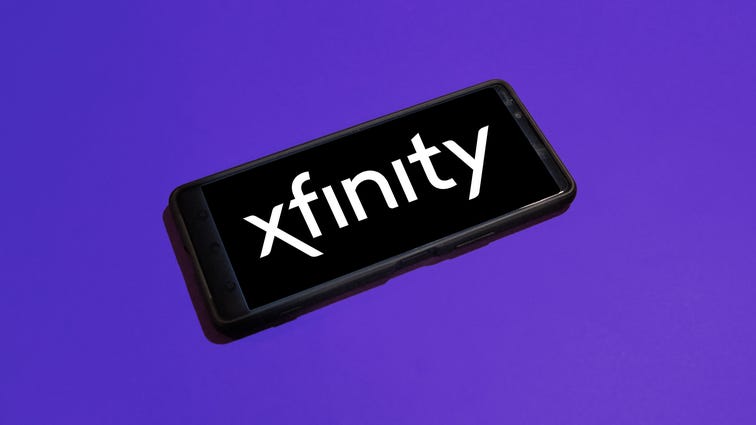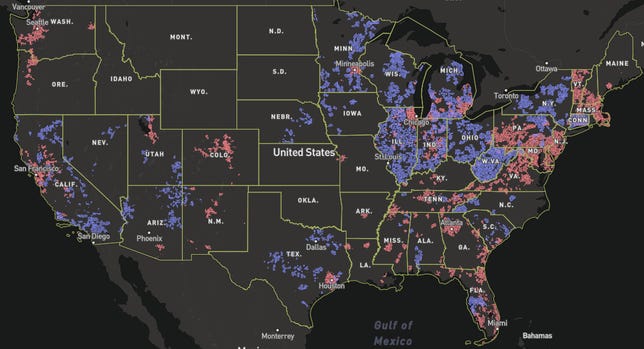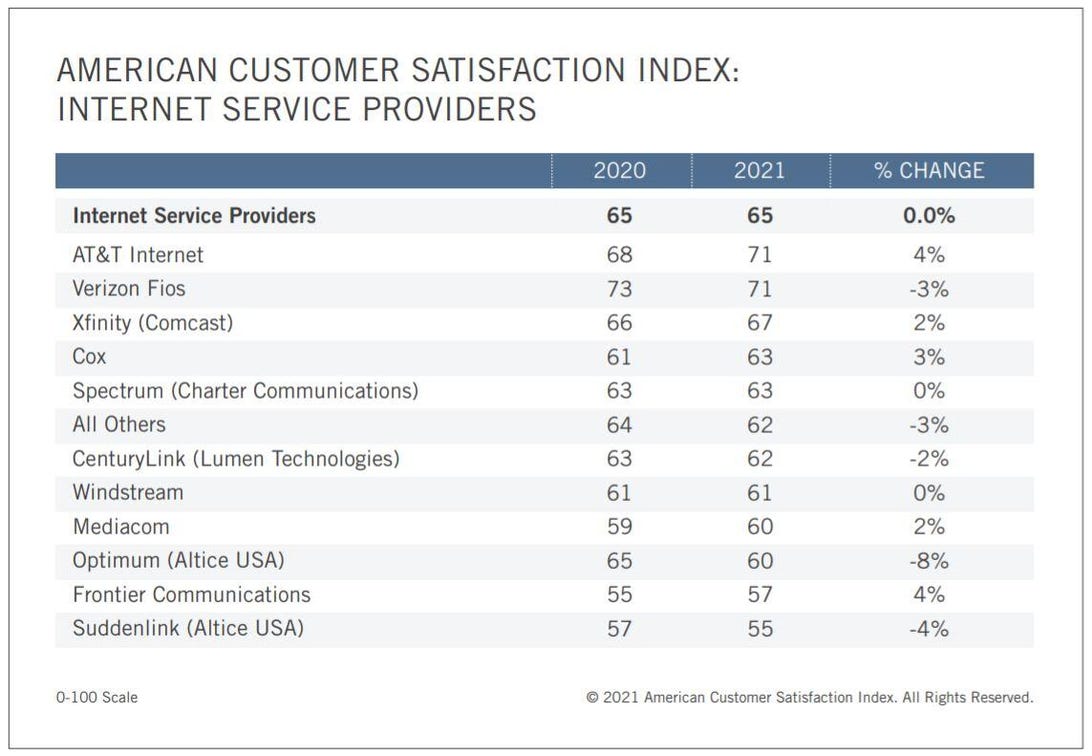It’s not a given that you’ll have more than one viable option when you’re shopping for high-speed home internet, but when you do, it’s well worth it to give the choices a close look and make sure you’re signing up for the best fit (and getting the best deal). It’s especially important when one or both wants to lock you into a contract — and that’s what you’ll find if you’re comparing internet services from Frontier and Xfinity.
Determining whether Frontier or Xfinity is better for your home could come down to several factors because, other than one or two similar plan tiers, the providers could not be more different. You’ll see what I mean below as I explore their technology, speeds, pricing, service details and customer satisfaction records. In the end, you’ll be better prepared to choose the right provider for your needs.

 \n ","topic":"","ttag":"","searchDim":"article-body|listicle|image","variant":"article-body|listicle|image","viewguid":"","event":"listicle|image|1","correlationId":"","_destCat":"https:\/\/www.allconnect.com\/cart-redirect?provider=frontier&bucket=[bucket_name]&element=[precap_or_listicle]","productName":"Frontier Communications","formatType":"IMAGE","location":"LIST","position":1,"sku":"CNETFrontier","dwLinkTag":"article-body|listicle|image","selector":"#article-body #listicle-d98fdd89-bbaf-44d8-b5dc-35a4f03c90a3 .itemImage"}}” rel=”noopener nofollow” target=”_blank”>
\n ","topic":"","ttag":"","searchDim":"article-body|listicle|image","variant":"article-body|listicle|image","viewguid":"","event":"listicle|image|1","correlationId":"","_destCat":"https:\/\/www.allconnect.com\/cart-redirect?provider=frontier&bucket=[bucket_name]&element=[precap_or_listicle]","productName":"Frontier Communications","formatType":"IMAGE","location":"LIST","position":1,"sku":"CNETFrontier","dwLinkTag":"article-body|listicle|image","selector":"#article-body #listicle-d98fdd89-bbaf-44d8-b5dc-35a4f03c90a3 .itemImage"}}” rel=”noopener nofollow” target=”_blank”>


Sarah Tew/CNET
Frontier FiberOptic is as good as any internet service provider, and in some ways better, when it comes to pricing, speeds and the fine-print details like equipment fees, contract requirements and data caps. In spite of fair pricing and favorable service terms, the ISP has suffered from consistently low customer satisfaction scores. I’d largely attribute the low scores to Frontier’s DSL service, which offers far less value, speed and reliability than FiberOptic.
Frontier Communications

 \n ","topic":"","ttag":"","searchDim":"article-body|listicle|image","variant":"article-body|listicle|image","viewguid":"","event":"listicle|image|2","correlationId":"","_destCat":"https:\/\/www.allconnect.com\/providers\/xfinity\/internet#header-shop-xfinity-internet-plans-near-you","productName":"Xfinity Internet","formatType":"IMAGE","location":"LIST","position":2,"sku":"CNETXfinity","dwLinkTag":"article-body|listicle|image","selector":"#article-body #listicle-3c02754c-acf5-483d-9f65-f42bdf2ec3f8 .itemImage"}}” rel=”noopener nofollow” target=”_blank”>
\n ","topic":"","ttag":"","searchDim":"article-body|listicle|image","variant":"article-body|listicle|image","viewguid":"","event":"listicle|image|2","correlationId":"","_destCat":"https:\/\/www.allconnect.com\/providers\/xfinity\/internet#header-shop-xfinity-internet-plans-near-you","productName":"Xfinity Internet","formatType":"IMAGE","location":"LIST","position":2,"sku":"CNETXfinity","dwLinkTag":"article-body|listicle|image","selector":"#article-body #listicle-3c02754c-acf5-483d-9f65-f42bdf2ec3f8 .itemImage"}}” rel=”noopener nofollow” target=”_blank”>


Sarah Tew/CNET
Other than Cox, another cable internet provider, I can’t think of another ISP that has quite as many plan options as Comcast’s Xfinity service. Customers will have six, maybe seven, plans to choose from, most of which are competitively priced but may require signing a contract to get the lowest pricing. You’ll also have to agree to a rather high equipment rental fee, a data cap with possible overage fees and a lofty price hike after one year. There are workarounds to all of that, such as using your own equipment or managing your data usage, but the added fees are an important consideration before you sign up.
Xfinity Internet


Availability and technology
According to the most recent Federal Communications Commission data, Xfinity is the second-largest internet provider in the US, available to more than 36% of the population. In contrast, Frontier is only available to around 10%. Looking at the map here (Frontier in blue, Xfinity in the orangish-pink), total coverage area appears to be about the same between the two, but Xfinity tends to operate in more densely populated areas whereas Frontier largely sticks to suburbs and rural areas, hence the vast difference in the population served.
If both of these providers are available at your home, the next thing to consider is the technology each provider uses.
Cable internet from Xfinity, which is what you’ll find in essentially all service areas, uses coaxial cables to run service to your home. While not without fault (low upload speeds, inconsistent speeds during peak usage times) cable internet generally supports download speeds up to a gigabit per second and offers decent connection quality.
Roughly two-thirds of those in Frontier service areas will only be eligible for DSL service, which is likely to come with slow, unsteady speeds. The remaining lucky third will be able to get Frontier FiberOptic, which has all the perks of a 100% fiber service — fast download and upload speeds, supreme reliability and less susceptibility to slowed speeds during peak usage times.
The Frontier connection type that’s available at your address should be the biggest factor when choosing between Frontier and Xfinity. If the answer is DSL, I’m confident that Xfinity will be your better option. On the other hand, if you can get Frontier FiberOptic service at your address, you’ll find FiberOptic’s speeds and overall value hard to pass up compared with cable internet from Xfinity.
Comparing internet plans and pricing
Frontier FiberOptic service presents four plan options, including a recently released multigigabit tier. Your options with DSL service are a bit more limited in that available speeds are at the mercy of your address. For more details about what to expect with Frontier DSL plans and speed variances, read our Frontier home internet review.
Frontier FiberOptic plan details
| Plan | Max speeds | Starting monthly price | Equipment fee | Data cap | Contract |
|---|---|---|---|---|---|
| FiberOptic 500 | 500Mbps download, 500Mbps upload | $50 | None | None | None |
| FiberOptic Gig | 940Mbps download, 880Mbps upload | $75 | None | None | None |
| FiberOptic 2 Gig | 2Gbps download, 2Gbps upload | $150 | None | None | None |
Frontier DSL plan details
| Plan | Max speeds | Starting monthly price | Equipment fee | Data cap | Contract |
|---|---|---|---|---|---|
| Frontier Basic Internet | 9Mbps download, 1Mbps upload | $33 | None | None | None |
| Frontier Preferred Internet | 25Mbps download, 1Mbps upload | $40 | None | None | None |
| Frontier Premium Internet | 115Mbps download, 3Mbps upload | $50 | None | None | None |
Xfinity internet plans may also vary depending on where you live, but the differences are less volatile than what you’ll get with Frontier’s DSL service. I’ve listed the lowest pricing for Xfinity plans below, but keep in mind that pricing and speeds may be different in your area. Check out our Xfinity review for a full rundown of potential plans and pricing.
Xfinity internet plan details
| Plan | Max speeds | Starting monthly price | Price after 12 months | Equipment fee | Data cap | Contract |
|---|---|---|---|---|---|---|
| Connect | 50Mbps download, 5Mbps upload | $20 | $50 | $14 | 1.2TB | 1 year |
| Connect More | 100Mbps download, 5Mbps upload | $40 | $60 | $14 | 1.2TB | 1 year |
| Fast | 300Mbps download, 10Mbps upload | $50 | $70 | $14 | 1.2TB | None |
| Superfast | 600Mbps download, 15Mbps upload | $60 | $80 | $14 | 1.2TB | None |
| Ultrafast | 900Mbps download, 20Mbps upload | $70 | $90 | $14 | 1.2TB | None |
| Gigabit Extra | 1,200Mbps download, 35Mbps upload | $80 | $100 | $14 | 1.2TB | None |
| Gigabit Pro | 3,000Mbps download, 3,000Mbps upload | $300 | $300 | $20 | 1.2TB | 2 years |
If you’re looking for cheap internet, Xfinity is going to be your best bet, as plans start at $20 per month for speeds up to 50Mbps in most service areas. But if you prefer more bang for your buck, Frontier FiberOptic — boasting 500Mbps, 1 Gig and 2 Gig plans — is the way to go. Pricing is about the same for comparable FiberOptic and Xfinity plans, but you’ll get significantly faster upload speeds, unlimited data, free equipment and no contract requirements with Frontier. It is worth noting, however, that Xfinity’s gig service comes with max speeds of 1,200Mbps in most locations, which is around 200Mbps more than what you’ll get from Frontier’s single-gig plan.
The argument could certainly be made that Xfinity has a slight advantage on speed tiers and introductory pricing, but what about after the first year of service? Xfinity plans come with a specified price increase after the first year — and a hefty one at that of $20 to $30 or more per month — while Frontier plans do not. That’s not to say Frontier won’t raise the price on you at some point, but there is no guarantee of a significant spike after a year.
A Frontier spokesperson informed CNET that prices generally go up by around $10 per month after the first year, but some customers may see no increase at all. On the flip side, there’s nothing to say prices won’t go up more than that, or that it will be the only price increase.
The fine print
Pricing and speeds are arguably the two most important considerations when comparing internet providers, but added fees and service terms can also come into play. That’s certainly the case with Frontier and Xfinity.
Equipment fees
Frontier includes equipment fees in the monthly cost, so there are no additional fees for renting equipment. Depending on the plan you sign up for, your provided equipment may include a Wi-Fi 6E router, which may be more advanced than the average home needs, but is still nice to have at no extra cost.
You can also get a top-of-the-line router with Xfinity, but it’ll cost you an added $14 per month, or $25 per month if you choose premium Wi-Fi service. There is the option to use your own equipment and skip the fee, but unless you already own a compatible router, there’s still the upfront cost of purchasing one to consider.
Data caps
Frontier plans come with unlimited data, so you don’t have to monitor your monthly data usage to avoid going over and incurring fees.
Xfinity internet comes with a monthly data cap, but it’s a generous 1.2TB (1,200GB). Exceeding that limit could add $10 for each 50GB block needed to satisfy your overage, but the good news is that the average household is unlikely to get anywhere close to going over. Even during the height of the pandemic, which drove millions of people to work and study from home, average data usage by household peaked at around 400GB per month, well below Xfinity’s 1.2TB limit. If you’re still concerned about going over, there is the option to sign up for unlimited data for an added $30 per month.
Contract requirements
Another tally for Frontier here. No contracts are required when signing up for Frontier internet.
Xfinity’s contract requirements are a bit more complicated. In some locations, a contract may not be required at all when signing up for anything less than Gigabit Pro service, which comes with a two-year contract everywhere the plan is available. In other areas, a one-year contract may be required to get the lowest introductory pricing. Opting out of a contract is possible in most locations, but doing so will mean sacrificing the low introductory pricing.


Customer satisfaction
Clear advantage for Xfinity here. The American Customer Satisfaction Index gave Xfinity a score of 67/100 in 2021, placing the provider at the top among cable ISPs and third overall, just behind AT&T and Verizon Fios. Frontier, despite a slight improvement from the previous year, came in a full 10 points lower than Xfinity and ranked next-to-last on the list, narrowly outperforming Suddenlink’s score of 55/100.
J.D. Power tells a similar story, ranking Xfinity slightly above average in each of its four regions while Frontier took the bottom spot in three out of the four. Xfinity came in second in the East and South regions with scores of 725 and 740 out of 1,000, respectively and third in the North-Central and West regions with scores of 716 and 723. As for Frontier, the provider did best in the South region with a score of 698, but received a 614 in the East, 622 in the North Central region and a 645 in the West.
Frontier’s low customer satisfaction scores are definitely a warning sign, but I wouldn’t call them a red flag. After reading an assortment of complaints against the company filed with the Better Business Bureau and reviewing the company’s official response, it’s apparent that much of the low customer satisfaction scoring can be attributed to the DSL side of the business along with service transfer disruptions after Frontier either acquired or sold networks from other providers.
There is unfortunately no separation of scores between Frontier’s DSL and FiberOptic service, so the low scores may be a false indicator of what customers can expect from the fiber service. In short, Xfinity is going to be the better option over Frontier’s DSL service anyway, regardless of customer satisfaction scores, but I wouldn’t let the scores influence my choice between Xfinity or Frontier FiberOptic.
In conclusion: Consider Frontier FiberOptic, but not DSL, over Xfinity
A good rule of thumb when shopping for home internet service is that fiber-optic is preferable to cable internet and cable is a better option than DSL, and that’s the case here when comparing Frontier and Xfinity. Frontier’s FiberOptic service boasts significantly faster upload speeds than Xfinity and the 100% fiber connection can also result in better performance and reliability. DSL paints a different picture, however, as indicated by Frontier’s low customer satisfaction numbers. If choosing between Frontier’s DSL service and Xfinity, you’ll find cable internet from Xfinity to offer faster speeds and better value than Frontier.


